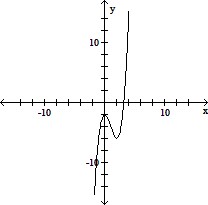Use the given transformation to evaluate the integral.

 Rwhere R is the parallelogram bounded by the lines
Rwhere R is the parallelogram bounded by the lines 


src="https://sciemce.com/media/4/ppg__as0610191830__f1q45g7.jpg" alt="" style="vertical-align: -4.0px;" />
A. - 
B. - 
C. - 
D. - 
Answer: B
Mathematics
src="https://sciemce.com/media/4/ppg__as0610191830__f1q45g7.jpg" alt="" style="vertical-align: -4.0px;" />
A. - 
B. - 
C. - 
D. - 
Answer: B
You might also like to view...
Use the graph of the function f(x) to locate the local extrema and identify the intervals where the function is concave up and concave down.
A. Local minimum at x = 0; local maximum at x = 2; concave down on (0, ?); concave up on (-?, 0) B. Local minimum at x = 0; local maximum at x = 2; concave up on (0, ?); concave down on (-?, 0) C. Local minimum at x = 2; local maximum at x = 0; concave down on (0, ?); concave up on (-?, 0) D. Local minimum at x = 2; local maximum at x = 0; concave up on (0, ?); concave down on (-?, 0)
Write the first four terms of the geometric sequence whose first term and common ratio are given.a = 3, r = -10
A. 3, -30, 300, -3000, . . . B. 3, -30, -90, -270, . . . C. 3, -30, 90, -270, . . . D. 3, -30, -300, -3000, . . .
Evaluate the expression according to the order of operations.60 ÷ 10 ? (14 - 3)
A. 81 B. 87 C. 66 D. 102
Solve the problem.Assume that you have a car worth $6000 and you wish to insure it for its full replacement value if it is stolen. If there is a 2% chance that the car will be stolen, what would a fair premium price be?
A. $126.45 B. $134.77 C. $107.41 D. $122.45